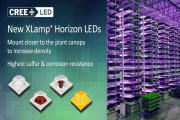Have you read Malcolm Gladwell’s longtime-bestseller The Tipping Point? In it, the author discusses the phenomenon where something goes from being marginal to mainstream. For LED (light-emitting diode) lighting, the tipping point has arrived. U.S. Department of Energy statistics show that about 49 million LEDs were installed in the U.S. in 2012 — saving about US $675 million in annual energy costs. And, switching entirely to LED lights over the next two decades could save the US $250 billion in energy costs, reduce electricity consumption for lighting by nearly 50 percent and avoid 1,800 million metric tons of carbon emissions. With benefits like these, it’s easy to see why the LED industry is rapidly expanding, and why commercial facilities, big and small, are turning to LEDs as their lighting application of choice.
LED is a type of solid-state lighting that uses a semiconductor to convert electricity into light. The Department of Energy says that today’s LED bulbs can be six to seven times more energy-efficient than conventional incandescent lights and can cut energy use by more than 80%. What’s more, the Department of Energy says good-quality LED bulbs can have a useful life of 30,000 to 50,000 hours or more — meaning they can last more than 30 times longer than traditional light bulbs.
What to expect?
Now that LEDs, and especially business LED lighting, have gained traction as a highly effective and beneficial way to light spaces, what can we likely expect from this technology in the months and years ahead?
-
Low prices. The average selling price of LED bulbs is continuing to decline as manufacturing competition intensifies. The Department of Energy recently reported that LED lamp $/klm pricing is expected to decrease roughly 55% by 2017, relative to current pricing, while a more modest decrease of 30% is projected for LED luminaires over the same period. Supply exceeding demand is putting downward pressure on pricing, so payback terms for LED upgrade installations are more attractive than they have ever been.
-
More lighting controls. Occupancy sensors, photo sensors, and wireless and cloud-based controls are gaining popularity in conjunction with LED lighting installations. Lights can be switched and controlled from a central network, and controls that eliminate over-lighting can significantly improve energy savings. What’s more, LEDs are easily dimmable and offer an almost linear progression of energy savings at dimmed settings. LEDs offer opportunities for control, monitoring and network connectivity that weren’t previously possible.
-
Ability to adjust color temperature. The digital nature of LED technology allows flexibility in controlling color and spectral content, which can have a variety of positive effects on people’s lives. Benefits range from improved sleep patterns and energy levels to enhanced productivity, better moods and speeded recovery from illness or injury. New products on the market include wall- and ceiling-mounted LED fixtures that provide indirect ambient illumination with a daylight-like appearance, and it can supplement or replace overhead lighting. For a full discussion about the potential and far-reaching benefits of variable LED lighting, see Stan Walerczyk’s article, “Human-Centric Lighting.”
-
More outdoor and overhead applications. LED technology for street lighting has evolved over the past several years and is gaining momentum as manufacturers have made advancements regarding cost, photometrics, thermal management, fixture durability and light color. Although LED fixtures are commonly more expensive than traditional lighting options, LED lighting offers many advantages that include: improved night visibility due to higher color rendering, significantly longer lifespan; lower energy consumption; reduced maintenance costs; and a lower environmental footprint. For many of the same reasons, the use of LEDs in parking garages can result in significant savings because these structures are often large and lights are typically left on at all times. In a parking garage setting, LED fixtures can create a bright, shadow-free environment that can improve the safety and comfort of employees and customers.
-





 CN
TW
EN
CN
TW
EN




